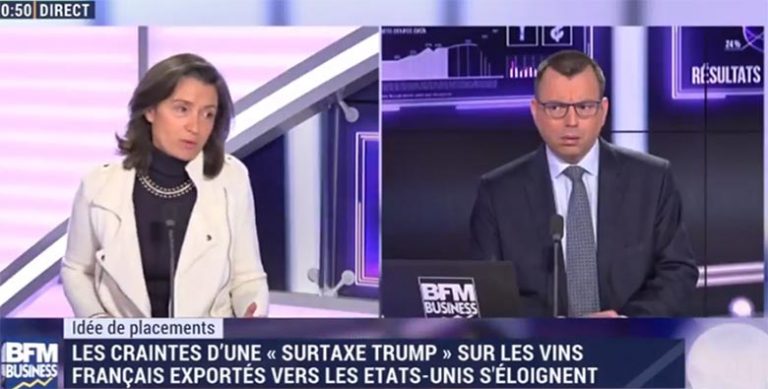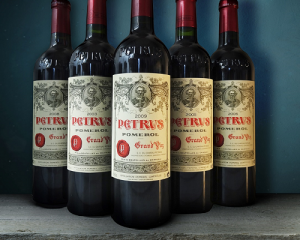
Every month, Angélique de Lencquesaing is interviewed on the BFM Business channel to discuss the news and market trends in the world of wine. Here is this month’s interview.
A few weeks ago we spoke about the fear surrounding a proposed ‘Trump tax’ on French wines exported to the United States. Has this fear been somewhat allayed?
It was actually a double threat! It was to do with two different conflicts between Europe and the USA: the Airbus-Boeing dispute that brought about a 25% tax on French wines in October 2019, then the question of Europe’s decision to apply the GAFA tax to digital companies. The latter led Donald Trump to threaten an increase of tax on wine from 25% to 100%. For now, this threat has been postponed, since the USA and Europe have decided upon an extra year of discussions around the digital tax. The wine industry isn’t directly involved in any of this, rather it is being used as a bargaining chip in negotiations between countries.
Now, there are two points that need to be clarified:
- On the one hand, the 25% tax applied to French wines since the 18th October 2019 seems to be here to stay, and there are sure to be consequences.
- On the other hand, we are not yet sure what will come of a possible revision of the list of products affected by the 25% tax.
What is it that might be revised later in February?
If the list of products currently affected by the tax is reviewed in light of continued negotiations, it is possible that some things will be added to it. For example, wines with over 14% ABV, sparkling wines, and whisky are not included at the moment. We should also note that the amount of tax itself could also be revised in February.
Another consequence could have an effect on competition: Italian wines, thus far excluded from the list of taxed products (since Italy is not a participant in the Airbus Group), could potentially be involved.
What are the consequences for the fine wine market and for investors?
Such unstable situations are rarely favourable to the market and can sometimes act as an obstacle.
At the level of production, the repercussions of the 25% tax were immediate, with no vineyard left unaffected.
Take Burgundy, for example, a region that has a high export rate, with 55% of its volume being shipped abroad. Louis-Fabrice Latour, President of the BIVB (Bureau interprofessionnel des vins de Bourgogne) indicated a few days ago that cancelled orders to the US brought about a 13% drop in shipments from November 2019.
As for us, the US represents around 5% of sales at iDealwine, and wine enthusiasts from the States totally stopped ordering at the end of the year. But then the threat of the 100% tax brought them back!
What have they been buying?
Mainly Burgundy wines, often the rarest bottles from Roumier, Dujac, reds from Lafarge, Coche-Dury, Roulot, and whites from Arnaud Ente, as well as natural winemakers from the Rhône Valley like L’Anglore and Gonon, and mature vintages from Clos Rougeard, a Loire domain. It’s an eclectic mix, but the common denominator is always rarity, most likely due to the difficulty of finding wines such as these in America.
So Bordeaux isn’t very popular with the Americans…Is the region suffering more than others at the moment?
Indeed, only a few bottles of fine Bordeaux were bought by American clients in our most recent sales. Generally speaking (not just in iDealwine’s auctions), wines from Bordeaux have been experiencing a drop, with a 46% decrease in sales revenue in November and 24% less volume exported to the American market.
However, at different levels in the production chain, distributors are chipping away at their profit margins in order to limit the impact of these taxes. This is why the representatives of the Bordeaux sector have been given a helping hand in the form of 300 million euros, and this will help to support the wine industry across France. This money is the equivalent of 25% of sales revenue generated by wine exported to the US.
Is Bordeaux’s success waning at auction as well? It will be important for investors to follow this.
No, this isn’t what we’ve seen. In our final sales of January, Bordeaux made up 46% in value and 45% in volume of wine sold, a percentage that is not out of line with what we expect. French buyers are a solid and loyal customer base, having acquired 56% (in value) of the Bordeaux bottles for sale. We should also mention that the European market outside France is very dynamic, representing 30% of Bordeaux purchases. Wines from Bordeaux are therefore still a safe investment, even if we aren’t currently seeing an upsurge in prices.
A little bit of advice: at the moment, it is best to avoid vintages ending in zero because of the ‘anniversary effect’. They are particularly sought-after now with the arrival of a new decade.
Sticking with the latest news, will the effects of the Coronavirus be felt in the fine wine market?
We are keeping a close eye on this, with wine evidently not being a necessity. In the middle of the Chinese New Year celebrations, the crisis could not have come at a worse moment. The last iDealwine auctions that closed last week didn’t demonstrate any significant change, with purchases in Asia still representing 15% of the volume sold. However, we will certainly have to prepare for several weeks of potential complications if China continues to be paralysed.
And we’ve not even spoken about Brexit…Will the export difficulties for big names in French wine open up investment opportunities for wine enthusiasts?
That’s right, in terms of iDealwine’s activity, China, Hong Kong, the UK and the USA are areas of strategic development.
But generally speaking, the big names are still just as attractive to foreign buyers, and despite the obstacles we’ve discussed here, it is still highly recommended to watch out for future stars. I would like to mention some wines that haven’t yet seen an explosion in popularity. No region escapes these trends. For example, it is currently in the Rhône Valley that we are seeing significant growth in prices. We’ve seen great success for the Languedoc with Domaine de la Grange des Pères’ first vintage (1992). Another bottle sold last week almost reached the levels of December’s record of €5,219. So who knows where the next superstar will come from…keep an eye on the Loire, Jura, and Alsace, just in case…
What should we be looking out for from the Rhône?
One of this region’s highest performers is Marius Gentaz-Dervieux, with his 1983 Côte-Rôtie Côte Brune doing particularly well. This is a winemaker whose domain no longer exists, and whose 1983 recently went for €2,395! In the south of the region, at Châteauneuf-du-Pape, two icons lit up the auctions with their 1990 vintage: unsurprisingly, Château Rayas (€1,474) and Henri Bonneau’s Célestins (€1,412).
Those are undoubtedly the stars, but which names are up and coming?
There are some names largely unknown to the wider public that are currently making waves at auction. These are some of our favourites: from the southern Rhône, there’s Gramenon, Vieux Télégraphe, and L’Anglore from Tavel. From the north, in Cornas, there’s Franck Balthazar and Alain Voge. There are two appellations that should be followed very closely: Saint-Joseph and Crozes-Hermitage, with particular emphasis on the domains of Gonon, Bernard Gripa, and Combier.
See all the wines available at iDealwine



